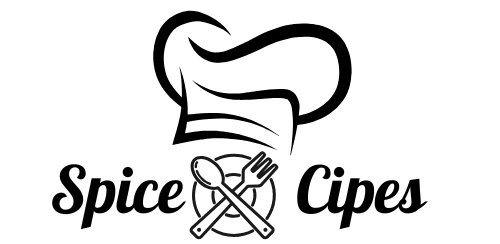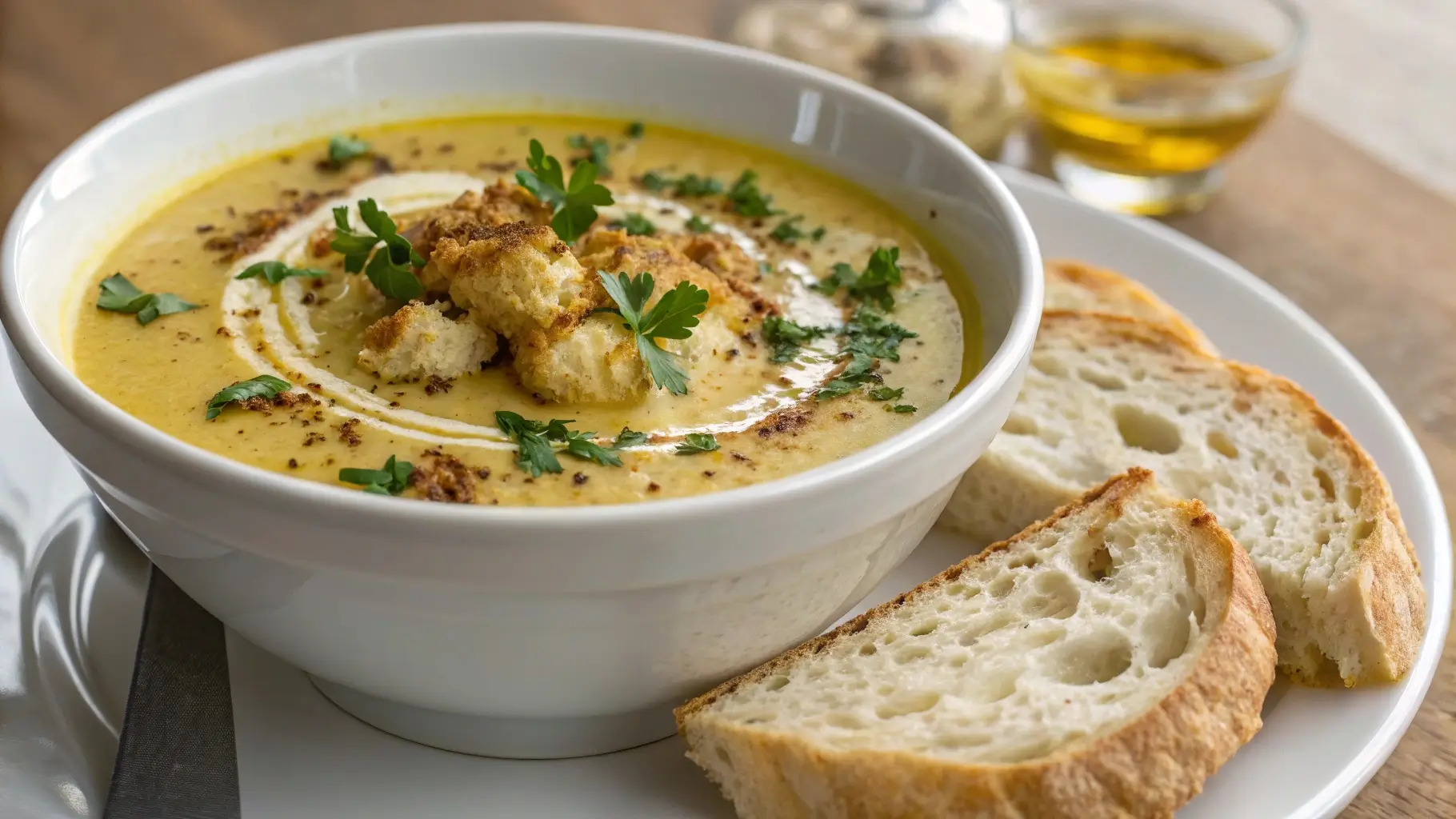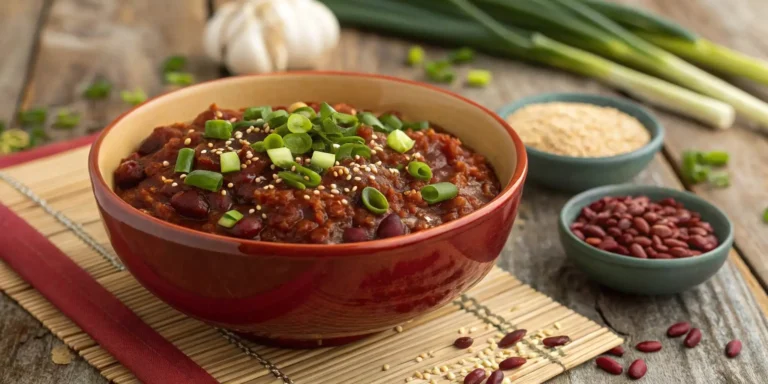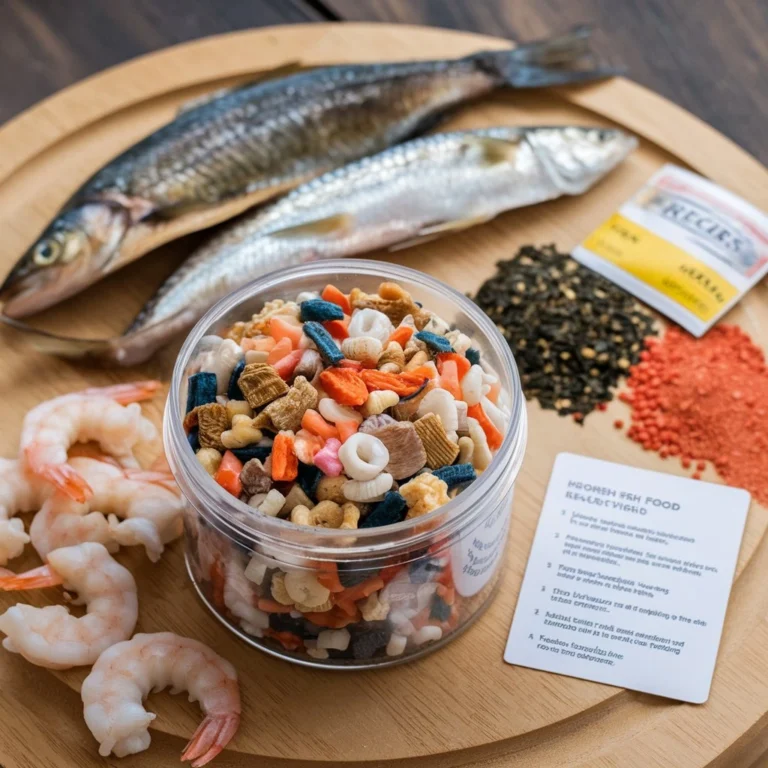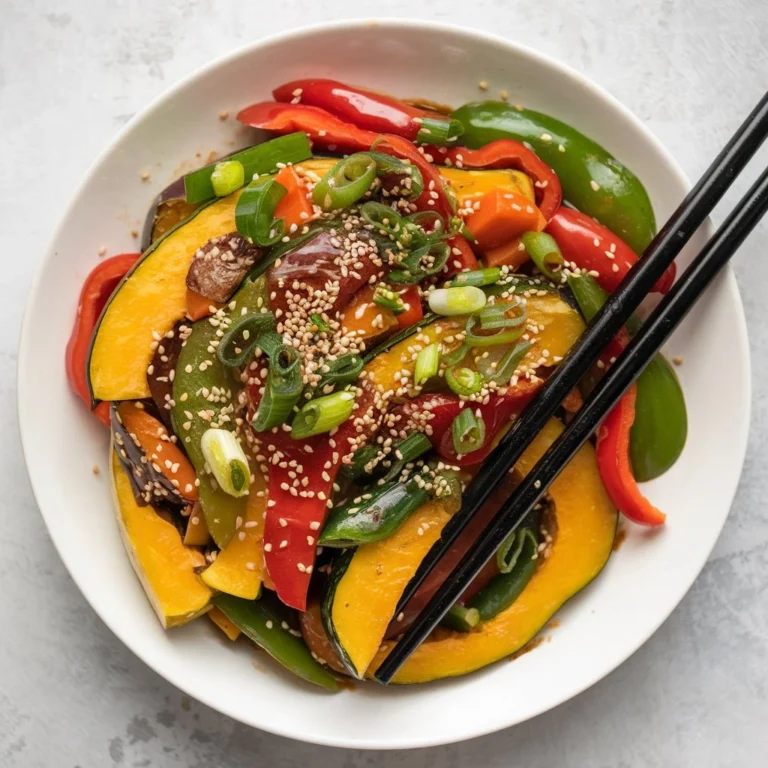Discover the Delight of Roasted Cauliflower and Garlic Soup
Are you ready to elevate your soup game? Roasted cauliflower and garlic soup is not only a culinary delight but also a powerhouse of nutrition. This creamy, vegan-friendly recipe is packed with vitamins and minerals, making it a heart-healthy choice for any meal. Moreover, the anti-inflammatory properties of garlic and the nutrient-rich cauliflower work together to support your immune system and digestive health. Whether you’re looking for a comforting dish on a chilly evening or a nutritious option for meal prep, this soup is sure to impress. So, let’s dive into the world of flavors and health benefits that roasted cauliflower and garlic soup has to offer!
Table of Contents
Key Benefits
Roasted cauliflower and garlic soup is not just a comforting dish; it’s a powerhouse of health benefits that can elevate your cooking experience. Here’s why you should consider making this delightful soup:
- Nutrient-rich: Cauliflower is packed with vitamins C and K, while garlic adds a boost of antioxidants. Together, they create a nutrient-dense meal.
- Immune-boosting: The combination of these ingredients supports your immune system, helping you stay healthy, especially during cold seasons.
- Creamy texture: Achieving a creamy consistency without dairy makes this soup a fantastic option for those on vegan diets.
- Low-calorie: This soup is low in calories, making it a guilt-free choice for those watching their weight.
- Heart-healthy: With its anti-inflammatory properties, roasted cauliflower and garlic soup is a heart-friendly meal that promotes overall wellness.
- Digestive health: The dietary fiber in cauliflower aids digestion, ensuring you feel good inside and out.
In summary, roasted cauliflower and garlic soup is not only delicious but also a smart choice for anyone looking to enjoy a nutritious meal. So, why not whip up a batch today? You’ll be glad you did!
Ingredients
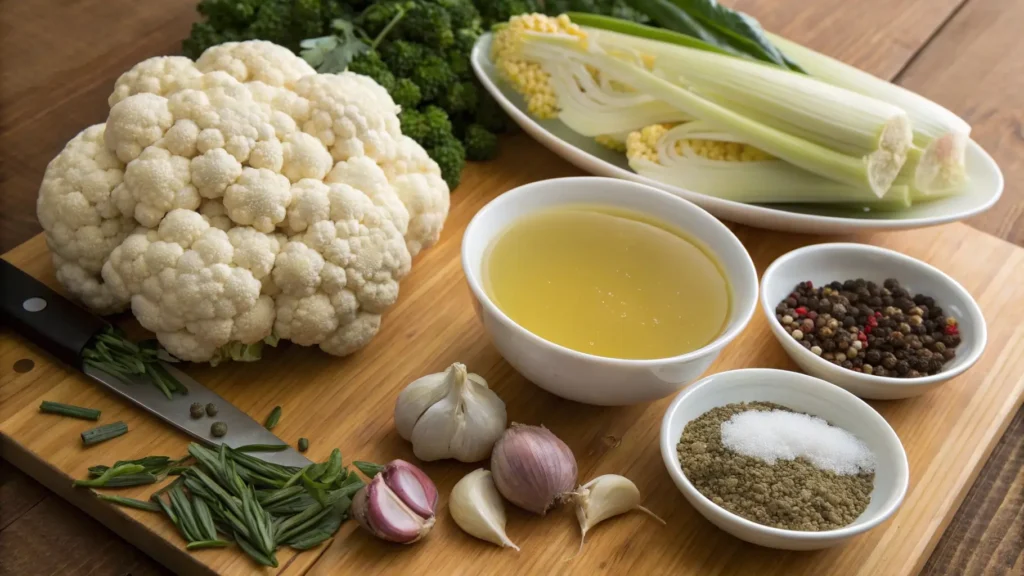
To create a flavorful roasted cauliflower and garlic soup, gather the following fresh ingredients:
- 1 medium head of fresh cauliflower, cut into florets
- 6-8 garlic cloves, peeled
- 4 cups vegetable broth
- 2 tablespoons olive oil
- 1 medium onion, chopped
- 1 teaspoon dried thyme (or a few sprigs of fresh thyme)
- Salt and pepper, to taste
- 2 tablespoons nutritional yeast (optional, for a cheesy flavor)
- Juice of 1 lemon
When selecting your cauliflower, look for firm, white florets without any brown spots. Fresh garlic is essential, as it adds a rich depth of flavor. If you’re in a pinch, you can substitute with garlic powder, but fresh garlic truly shines in this recipe. Additionally, feel free to use low-sodium vegetable broth to control the saltiness of your soup. For a heartier version, consider adding a potato for extra creaminess. Lastly, a splash of lemon juice at the end brightens the soup, enhancing its natural sweetness and balancing the flavors beautifully.
How to Make Roasted Cauliflower and Garlic Soup
Making roasted cauliflower and garlic soup is a delightful journey that combines simple ingredients with rich flavors. Follow these steps to create a creamy, nutrient-rich soup that’s perfect for any occasion.
- Preheat Your Oven: Begin by preheating your oven to 425°F (220°C). This high temperature will help caramelize the cauliflower and garlic, enhancing their natural sweetness.
- Prepare the Cauliflower: While the oven heats, wash and chop one large head of fresh cauliflower into bite-sized florets. This ensures even roasting. Additionally, peel and smash about 6 garlic cloves, leaving them whole for roasting.
- Toss with Olive Oil: In a large bowl, combine the cauliflower florets and garlic cloves. Drizzle with 2 tablespoons of olive oil, then sprinkle with salt and pepper. Toss everything together until well-coated. This step is crucial for flavor infusion.
- Roast the Vegetables: Spread the cauliflower and garlic on a baking sheet in a single layer. Roast in the preheated oven for about 25-30 minutes, or until the cauliflower is golden brown and tender. Remember to stir halfway through for even cooking.
- Sauté the Onions: While the vegetables roast, heat a tablespoon of olive oil in a large pot over medium heat. Add one chopped onion and a teaspoon of dried thyme. Sauté until the onion is translucent and fragrant, about 5 minutes. This adds depth to your soup.
- Combine Ingredients: Once the cauliflower and garlic are roasted, add them to the pot with the sautéed onions. Pour in 4 cups of vegetable broth, then bring the mixture to a simmer. This step allows the flavors to meld beautifully.
- Blend Until Smooth: After simmering for about 10 minutes, remove the pot from heat. Using an immersion blender, blend the soup until smooth and creamy. If you don’t have an immersion blender, carefully transfer the mixture to a countertop blender in batches.
- Adjust the Flavor: Taste your soup and adjust the seasoning as needed. A splash of lemon juice can brighten the flavors, while nutritional yeast can add a cheesy depth. This is where you can personalize your roasted cauliflower and garlic soup.
- Serve and Enjoy: Ladle the soup into bowls and garnish with a drizzle of olive oil or a sprinkle of nutritional yeast. Pair it with crusty bread or a fresh salad for a complete meal. Enjoy the warmth and comfort of this heart-healthy dish!
By following these steps, you’ll create a creamy, vegan-friendly roasted cauliflower and garlic soup that’s not only delicious but also packed with vitamins and antioxidants. Enjoy your cooking adventure!
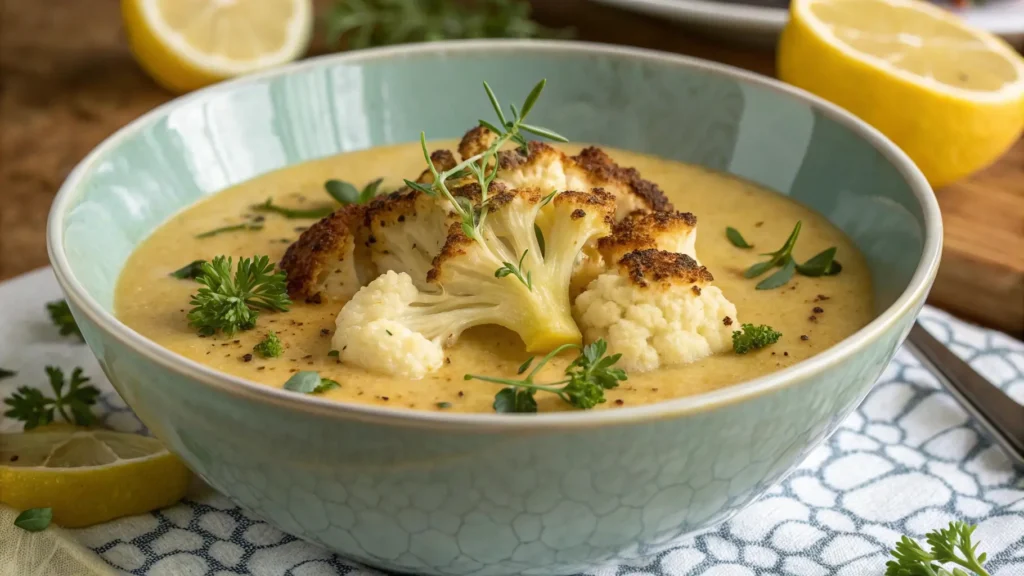
Pro Tips, Variations, and Common Problems
When it comes to making roasted cauliflower and garlic soup, a few pro tips can elevate your dish from good to remarkable. Firstly, always use fresh cauliflower and garlic for the best flavor. Additionally, roasting these ingredients until they are golden brown enhances their natural sweetness, creating a depth of flavor that is simply irresistible.
Here are some expert tips to consider:
- Texture Adjustments: For a velvety soup, use a high-powered blender. However, if you prefer a chunkier texture, reserve some roasted cauliflower to stir in after blending.
- Flavor Enhancements: If your soup tastes bland, try adjusting the seasonings. A splash of vinegar or lemon juice can brighten the flavors significantly. Moreover, consider adding spices like cumin or curry for a unique twist.
- Ingredient Substitutions: If you don’t have vegetable broth, chicken broth works well too. For a creamier texture without dairy, add a splash of coconut milk or cashew cream.
- Storage Tips: To keep your soup fresh, store it in airtight containers. It can last up to five days in the refrigerator or be frozen for longer storage.
Now, let’s address some common problems you might encounter:
- Overcooking: If you overcook the cauliflower, it may become mushy. To avoid this, roast until just tender and caramelized, checking frequently.
- Seasoning Issues: If your soup lacks flavor, it might need more salt or herbs. Taste as you go and adjust accordingly.
- Texture Problems: If your soup is too thick, simply add more broth until you reach your desired consistency. Conversely, if it’s too thin, simmer it a bit longer to thicken.
By keeping these tips and troubleshooting advice in mind, you’ll create a delicious roasted cauliflower and garlic soup that is both comforting and nourishing. Enjoy the process, and don’t hesitate to experiment with flavors!
Serving Suggestions
When it comes to serving your roasted cauliflower and garlic soup, presentation is key. Not only does it enhance the dining experience, but it also makes the dish even more inviting. Here are some delightful ideas to elevate your soup:
- Garnishes: A drizzle of high-quality olive oil adds a touch of elegance. Additionally, sprinkle some nutritional yeast on top for a cheesy flavor without dairy.
- Accompaniments: Pair your soup with crusty bread or a warm baguette. This combination not only complements the creamy texture of the soup but also provides a satisfying crunch.
- Salad Pairings: A fresh green salad with a light vinaigrette can balance the richness of the soup. Consider adding ingredients like arugula, cherry tomatoes, and avocado for a nutrient-rich side.
- Creative Presentation: Serve the soup in rustic bowls or even hollowed-out bread bowls for a fun twist. Furthermore, topping it with fresh herbs like parsley or chives can add a pop of color.
- Casual vs. Elegant Settings: For a casual meal, serve the soup family-style in a large pot, allowing everyone to help themselves. Conversely, for a more elegant dinner, ladle the soup into individual bowls and garnish each one beautifully.
Ultimately, the way you serve your roasted cauliflower and garlic soup can transform a simple dish into a memorable dining experience. So, whether you’re hosting a dinner party or enjoying a cozy night in, these serving suggestions will surely impress your guests.
Preserving and Reheating Roasted Cauliflower and Garlic Soup
To ensure your roasted cauliflower and garlic soup remains as delightful as the day you made it, proper storage is key. First, allow the soup to cool completely before transferring it to airtight containers. This step is crucial because it prevents condensation, which can lead to spoilage. In the refrigerator, your soup will stay fresh for up to five days. If you want to keep it longer, consider freezing it.
When stored in a freezer-safe container or vacuum-sealed bag, the soup can last for up to three months. However, remember to label your containers with the date to keep track of freshness. Additionally, always practice food safety by ensuring your soup is cooled quickly and stored promptly to prevent bacterial growth.
Reheating Methods
When it comes to reheating your roasted cauliflower and garlic soup, there are several effective methods to choose from. For the best results, I recommend reheating on the stovetop. Simply pour the soup into a saucepan and warm it over medium heat. Stir occasionally to ensure even heating. If the soup appears too thick, add a splash of vegetable broth or water to restore its creamy texture. Alternatively, you can use the microwave for convenience.
Transfer the soup to a microwave-safe bowl, cover it loosely, and heat in 30-second intervals, stirring in between, until hot. This method helps prevent overheating and keeps the soup from drying out. If you prefer using an oven, pour the soup into an oven-safe dish, cover it with foil, and heat at 350°F (175°C) for about 20 minutes, or until warmed through. Regardless of the method you choose, always taste and adjust the seasoning if necessary. A squeeze of fresh lemon juice can brighten the flavors beautifully, making your reheated soup just as enjoyable as the first serving.
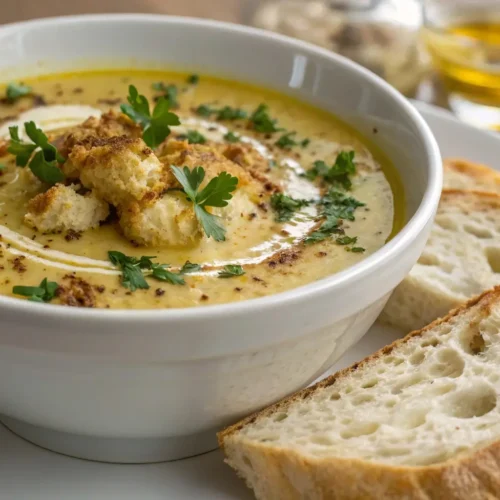
roasted cauliflower and garlic soup
Ingredients
Fresh Ingredients
- 1 medium head fresh cauliflower Cut into florets
- 6-8 cloves garlic Peeled
- 4 cups vegetable broth Low-sodium optional
- 2 tablespoons olive oil For roasting and sautéing
- 1 medium onion Chopped
- 1 teaspoon dried thyme Or a few sprigs of fresh thyme
- to taste salt and pepper
- 2 tablespoons nutritional yeast Optional, for a cheesy flavor
- 1 lemon juice For brightness
Instructions
Preparation
- Preheat your oven to 425°F (220°C). Wash and chop the cauliflower into florets and peel the garlic cloves.
Roasting
- Toss the cauliflower and garlic with olive oil, salt, and pepper. Spread on a baking sheet and roast for 25-30 minutes.
Sautéing
- While the vegetables roast, heat olive oil in a pot and sauté the onion and thyme until translucent.
Combining
- Add the roasted cauliflower and garlic to the pot, pour in the vegetable broth, and simmer for 10 minutes.
Blending
- Blend the soup until smooth using an immersion blender.
Final Touches
- Adjust seasoning with salt, pepper, and lemon juice. Serve hot, garnished with olive oil or nutritional yeast.
Notes
| Calories | Fat | Protein | Carbs |
|---|---|---|---|
| 150 | 7g | 4g | 20g |
Conclusion
In conclusion, making roasted cauliflower and garlic soup is a delightful journey that combines simplicity with incredible flavor. By roasting fresh cauliflower and aromatic garlic, you unlock their natural sweetness, creating a creamy texture that is both comforting and nutritious. This nutrient-rich soup is not only low-calorie but also heart-healthy, making it an excellent choice for anyone looking to enjoy a wholesome meal. So, whether you’re preparing a cozy dinner for yourself or a family gathering, this easy recipe is sure to impress.
Moreover, I encourage you to share your results or ask any questions you may have. Cooking is all about experimentation, so feel free to try different variations or pairings that suit your taste. For instance, adding spices like cumin or a splash of lemon juice can elevate the flavors even further. Remember, the kitchen is a space for creativity and joy, and this roasted cauliflower and garlic soup is a perfect canvas for your culinary adventures.
Ultimately, I hope you feel inspired to dive into this recipe and enjoy the process. Happy cooking, and I can’t wait to hear about your delicious creations!
FAQs
Here are some common questions about roasted cauliflower and garlic soup that might help you in your cooking journey!
Can I use frozen cauliflower?
Yes, you can use frozen cauliflower for your roasted cauliflower and garlic soup. Just remember to adjust the cooking time accordingly, as frozen vegetables may take a bit longer to roast.
Is this soup suitable for a gluten-free diet?
Absolutely! All the ingredients in roasted cauliflower and garlic soup are naturally gluten-free, making it a safe choice for those with gluten sensitivities.
What can I substitute for garlic?
If you need a garlic substitute, you can use garlic powder or shallots for a milder flavor. This way, you can still enjoy the essence of the soup without the strong garlic taste.
How can I enhance the flavor of my soup?
To enhance the flavor of your roasted cauliflower and garlic soup, consider adding a splash of lemon juice or a dash of vinegar. These ingredients brighten the soup and elevate its overall taste.
Can I make this soup ahead of time?
Yes, you can prepare roasted cauliflower and garlic soup ahead of time. Simply store it in an airtight container in the refrigerator for up to five days. Reheat gently on the stovetop or in the microwave, adding a bit of broth to restore its creamy texture.
